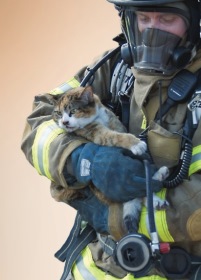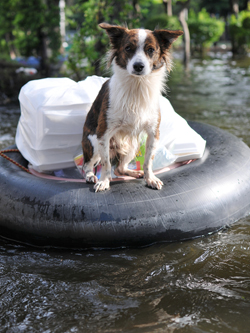Planning for pets in emergencies
Your pets are your responsibility. Failing to plan ahead for your pets' safety during an emergency puts everyone's lives at risk.
This information will help you prepare for the welfare of your pets during emergency events, such as bushfires or floods.
Plan ahead
 Prepare an emergency plan
Prepare an emergency plan
- Prepare an emergency plan that covers the major disasters which have the potential to impact on your family, including your pets.
- Discuss your plan, record it, and practice it with your family or housemates.
- Place your plan somewhere prominent — on the fridge or by the front door.
- Refer to the Country Fire Authority for guidance on developing a bushfire survival plan.
Access to water
- Ensure your pets always have a water supply that will last them several days, even if you expect to be home that evening.
- Water containers must be unspillable.
Backup person for your pets
- Choose a trusted neighbour, family member or friend and give them a key to your house in case they need to access your pets.
- Make sure this person is comfortable and familiar with your pets.
- Keep this person's contact details with you at all times.
 Temporary housing
Temporary housing
- Prepare a list of preferred boarding kennels, catteries, animal shelters or friends that would be prepared to temporarily house and care for your pets in case of an emergency.
Identification
- Ensure your pets are identified with a visible marker such as a collar and council registration tag, as well as permanently identified with a microchip.
- Make sure your contact details are correct with both your local council, and your microchip registry (include several alternative contact numbers in case you can't be reached).
Vaccinations
- Ensure your pet's vaccinations are always up to date (and you have the certificates), in case they need to be admitted to a boarding facility or shelter.
Prepare an emergency kit
In the event of an emergency, you and your pet may have to leave your property at very short notice.
In some cases, it may be someone else who collects your pet on your behalf.
A pet emergency kit will ensure that everything your pet needs is easily identified and can be transported with your pet to its temporary accommodation.
An emergency kit should include:
- Food and water containers. Include enough food and water for at least 3 days.
- Leads for dogs, along with a chain suitable for tethering if possible.
- A cage, carrier or container appropriate to the species, for each small pet (including cats, birds, guinea pigs, fish or reptiles), for transportation and housing purposes. Make sure the cage is big enough and has a litter tray that suits the animal, as each animal may need to live in its cage or carrier for a few days.
- Clearly label each cage or carrier with your contact details. Owning enough carriers to accommodate your pets and ensuring they fit in your vehicle allows for a speedy evacuation.
- An information list including your name, address and phone numbers, your pet's name, description and care requirements.
- Pet first aid items and essential medications.
- Pet medical history, vaccination certificate and veterinary contacts.
- Blankets, towels and bedding.
- Pet registration, identification and licensing records.
- Litter for cats or other small animals.
Emergency kits should be located somewhere that will be easily accessible in case you need to evacuate quickly.
Evacuating with pets
- The safest option for people and pets in bushfire prone areas is to leave early or the night before on days of an Extreme or Catastrophic fire danger rating. Late evacuation can be a deadly option.
- The same applies where impacts from storm or flood are possible as rainfall can vary greatly from weather forecast and flash flooding can occur quickly and without warning.
- If you have to go to work on days of high fire danger or flood, consider taking your animals to a safer place before leaving home. Keep in mind that you may not be allowed home for some time, so ensure that your pet emergency kit accompanies your pet wherever you take it.
- On high risk days, don't let your pets outside unsupervised, as they may take fright and run away, particularly in thunderstorms.
- Pets that are normally well behaved may become fearful and nervous during an emergency. Under no circumstances should animals be left in vehicles. Always carry a thermos filled with fresh, cool water when travelling.
- Allow enough time to act — stay aware of possible emergencies, especially when severe or extreme weather events may cause flash flooding, or when a fire warning has been issued. Decide what you are going to do as early as possible.
- Know which evacuation routes you will take to reach evacuation sites.
- Contact your preferred boarding facility, animal shelter or evacuation site to let them know you are coming. Note that emergency accommodation at animal shelters and boarding facilities may not be available, or be very limited. If you plan to take your family to an evacuation centre, find out ahead of time if there will be facilities available for your animals. Load your pets for transport, and pack your pet evacuation kit into your vehicle along with any additional supplies you feel you might need.
- Animals being evacuated, even with their family, experience great stress. Make sure they always have access to food and water and can relieve themselves regularly. Try to keep them in a calm and quiet area of the evacuation centre and, where possible, allow them some regular exercise.
Pets remaining on the property
- If you can't take your pets with you and they need to be left behind during an emergency leave them in a secure area inside your home or in a place where they will have the best protection possible.
- Don't tie animals outside or keep them in a vehicle unattended.
- Leave at least 10 days supply of water. Fill multiple bowls — don't leave just one container as it may spill.
- You can fill sinks and bathtubs too. If your toilet bowl is free of chemical disinfectants, leave the toilet seat up to provide animals with one more source of water.
- Leave at least 4 to 5 days supply of dry food. Canned food will go off quickly.
- If flooding is a threat, ensure your pet has access to elevated areas that will allow it to stay out of the water.
After the emergency
- If your pets are injured, seek veterinary treatment immediately.
- If your pets are lost, notify your local council, microchip registry, neighbours and nearby animal shelters. You can also check social media sources (often in emergencies a site is set up to list lost and found animals).
Checklist
- Have you included your pets, horses and livestock in your emergency plan?
- Are your pets identified with a collar and council registration tag as well as a microchip?
- Are your contact details current and correct in the microchip database and with your council?
- Are your pet's vaccinations up to date (you will need a current vaccination certificate for your pet to stay at a kennel or cattery)?
- Have you prepared a pet emergency plan and disaster kit and placed it in a prominent place? Does it include food, water, bowls, leads, blankets or bedding, medication, relevant documentation and a travel cage where necessary?
- Have you identified where you will evacuate your pets to? Have you checked with your local council about evacuation options that include facilities for animals?
- Have you determined which evacuation routes are available and safe in an emergency?
- If you cannot take your pets with you, have you left them in a protected space and provided at least 10 days supply of water, in multiple unspillable containers, and left at least 4 to 5 days supply of dry food?
Further information
- Caring for animals during extreme heat
- Horses and livestock in emergencies
- Horses affected by bushfires
- For a video on planning to evacuate pets, see RSPCA South Australia.
- For more information about planning for your animals in emergencies, visit World Animal Protection to order your free disaster pack.
- animal welfare in emergencies
- you can contact us.
Page last updated: 20 Aug 2025